| Rye %: | 100% |
| Stages: | Sponge, Scald, 2-Stage sponge-scald |
| Leaven: | Rye sour culture, Instant yeast |
| Start to Finish: | 28-32 hours |
| Hands-on Time: | 45-50 minutes |
| Yield: | One 3.15 lb/1.40 kg loaf |
Latgalian Rye is one of those complex Baltic breads I’d been meaning to make for some time, but life, as usual, got in the way. Finally, having found the time to devote to this flavorful, technically interesting Baltic rye, I took the plunge.
Like other Latvian rye breads I’ve eaten, this one features a dark, chewy crust, close yet tender crumb and distinctive sweet-sour flavor profile. Likewise, the use of multiple pre-doughs, including not just a sponge, but also a scald and two sour-scalds, produce enormously complex and nuanced flavors.
The magic starts with a 60% hydrated sponge, which favors acetic acid (vinegar) production, and a high-temperature, 12-hour rye flour/pale (diastatic) rye malt/caraway scald that not only unlocks the natural sweetness of the rye, but also transforms the caraway’s assertive astringency into a floral aromatic reminiscent of anise.
Now for the really interesting stuff: the first sponge-scald ripens at 130°F/55°C, which is the borderline temperature at which its resident microorganisms die and amylase enzyme-driven starch to sugar conversion starts to peak. The result is greater flavor intensity on both the sweet and sour scales. Meanwhile, the second sponge-scald simply entails the addition of a small amount of yeast and overnight ripening at room temperature (70°F/21°C). This restores the leavening power that the first stage eliminated with the death of the yeast contributed by the sponge without significantly affecting the sweetness of the loaf.
Finally, the long first-stage bake at 480°F/250°C not only maximizes oven spring, but also produces the dark, chewy crust I’ve encountered in almost all the Baltic ryes I’ve eaten, while a starch-and-water glaze applied at the end of the bake gives the loaves their characteristic glossy finish.
In all this is a wonderful, best-of-breed loaf that pairs beautifully with cured and smoked meats, strong cheeses and pickled herring.
Scald (Day 1, Evening):
| Ingredient |
Grams |
Ounces |
Baker’s |
| Wholegrain rye flour |
320 |
11.30 |
100% |
| Hot (150°F/65°C) water |
650 |
22.95 |
203% |
| Pale rye malt |
20 |
0.70 |
6% |
| Caraway seed, ground |
2 |
0.05 |
1% |
In the mixer bowl, mix the scald ingredients by hand into a firm porridge, cover and let stand at 150°F/65°C until it smells like apples, has a sweet taste and the consistency of pancake batter, 16-18 hours.
Sponge (Day 1, Evening):
| Ingredient |
Grams |
Ounces |
Baker’s |
| Wholegrain rye flour |
50 |
1.75 |
100% |
| Warm (105°F/41°C) water |
30 |
1.05 |
60% |
| Rye sour culture |
20 |
0.70 |
40% |
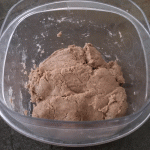 Mix the sponge ingredients by hand into a stiff dough, cover and ferment at room temperature (70°F/21°C) overnight, 16-18 hours, until the sponge has visibly expanded and has a pronounced vinegar smell.
Mix the sponge ingredients by hand into a stiff dough, cover and ferment at room temperature (70°F/21°C) overnight, 16-18 hours, until the sponge has visibly expanded and has a pronounced vinegar smell.
Sour-Scald 1 (Day 2, Noon)
| Ingredient |
Grams |
Ounces |
Baker’s |
| Sponge |
100 |
3.55 |
100% |
| Scald |
992 |
35.00 |
992% |
Combine the sponge and scald, cover and let stand at 130°F/55°C until it has a strong smell of apple cider, 6-7 hours.
Sour-Scald 2 (Day 2, Afternoon)
| Ingredient |
Grams |
Ounces |
Baker’s |
| Sour-Scald 1 1 |
1092 |
38.50 |
100% |
| Instant yeast, ¼ tsp |
1 |
0.05 |
0.01% |
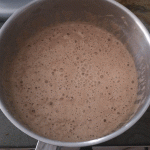 Add the instant yeast to Opara 1, stir to blend, cover and ferment overnight, 10-12 hours, at room temperature. In the morning, the mixture will be extremely bubbly and have a distinctive sweet-sour taste.
Add the instant yeast to Opara 1, stir to blend, cover and ferment overnight, 10-12 hours, at room temperature. In the morning, the mixture will be extremely bubbly and have a distinctive sweet-sour taste.
Final Dough (Day 3, Morning):
| Ingredient |
Grams |
Ounces |
| Sponge-Scald 2 |
1093 |
38.55 |
| Wholegrain rye flour |
600 |
21.15 |
| Water |
100 |
3.55 |
| Salt |
5 |
0.20 |
| Honey |
30 |
1.05 |
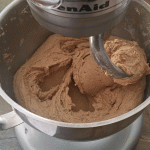 Add the final dough ingredients to the Opara 2 and use the dough hook at low (KA2) speed to mix until the dough is fully blended into a firm, sticky mass that gathers around the hook, 7-8 minutes.
Add the final dough ingredients to the Opara 2 and use the dough hook at low (KA2) speed to mix until the dough is fully blended into a firm, sticky mass that gathers around the hook, 7-8 minutes.
 Turn the dough onto a well-floured work surface and used floured hands to shape it into an oblong loaf, then place it on a well-floured peel, if using a baking stone, or on a parchment-lined sheet pan.
Turn the dough onto a well-floured work surface and used floured hands to shape it into an oblong loaf, then place it on a well-floured peel, if using a baking stone, or on a parchment-lined sheet pan.
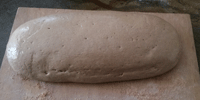 Brush the loaf with water, cover it with a tea towel and proof at room temperature, brushing with water every 15 minutes, until it has expanded to about 1 ½ times its original volume and shows cracks and broken bubbles, 45-50 minutes.
Brush the loaf with water, cover it with a tea towel and proof at room temperature, brushing with water every 15 minutes, until it has expanded to about 1 ½ times its original volume and shows cracks and broken bubbles, 45-50 minutes.
Preheat the oven to 480°F/250°C with the baking surface in the upper third. Brush the loaf with water and bake without steam for 40-45 minutes, then reduce the temperature to 390°F/200°C and continue to bake until the loaves thump when tapped with a finger and the internal temperature is at least 200°F/93°C, about 20 minutes more.
Glaze:
| Ingredient | Grams | Ounces |
| Cornstarch or potato starch, 1 tsp |
3 |
0.10 |
| Water, 1 cup |
227 |
8.00 |
Bring about three-fourths of the water to a boil. Dissolve the starch in the remaining water and add it to the boiling water, stirring constantly until the mixture thickens. Brush the hot glaze on the top crust and return the loaf to the oven until the glaze sets, 3-4 minutes. Transfer to a rack and cool thoroughly before slicing.
Baker’s Percentages:
| Ingredient |
g |
% |
| TOTAL FLOUR |
990 |
100.00% |
| Whole rye flour |
970 |
97.98% |
| Malted rye |
20 |
2.02% |
| Water |
680 |
68.69% |
| Salt |
5 |
0.51% |
| Instant yeast |
0.5 |
0.05% |
| Rye sour culture |
20 |
2.02% |
| Honey |
30 |
3.03% |
| Caraway |
2 |
0.20% |
| TOTAL FORMULA |
1,728 |
174.49% |
| Flour Prefermented |
390 |
39.39% |

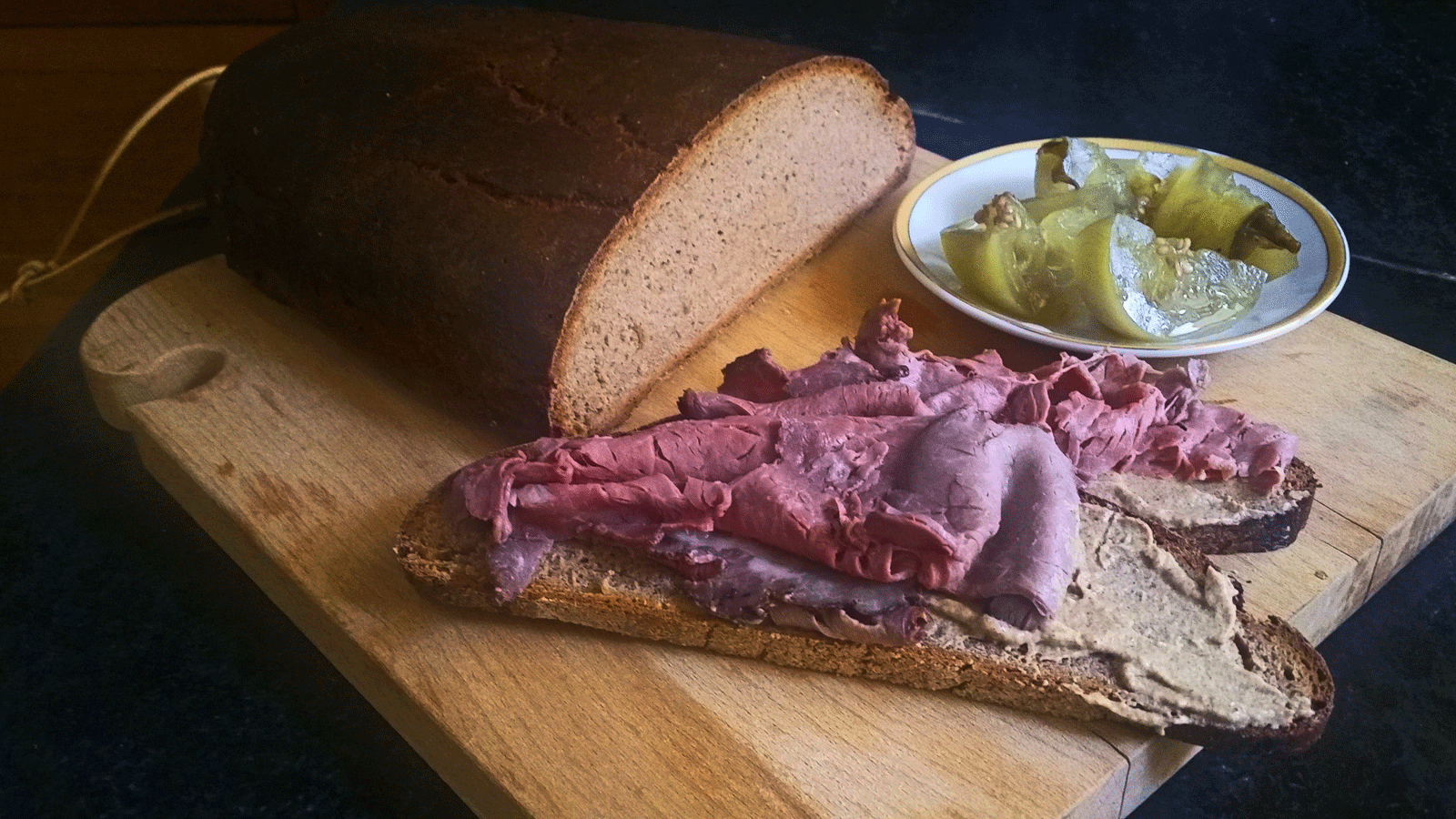
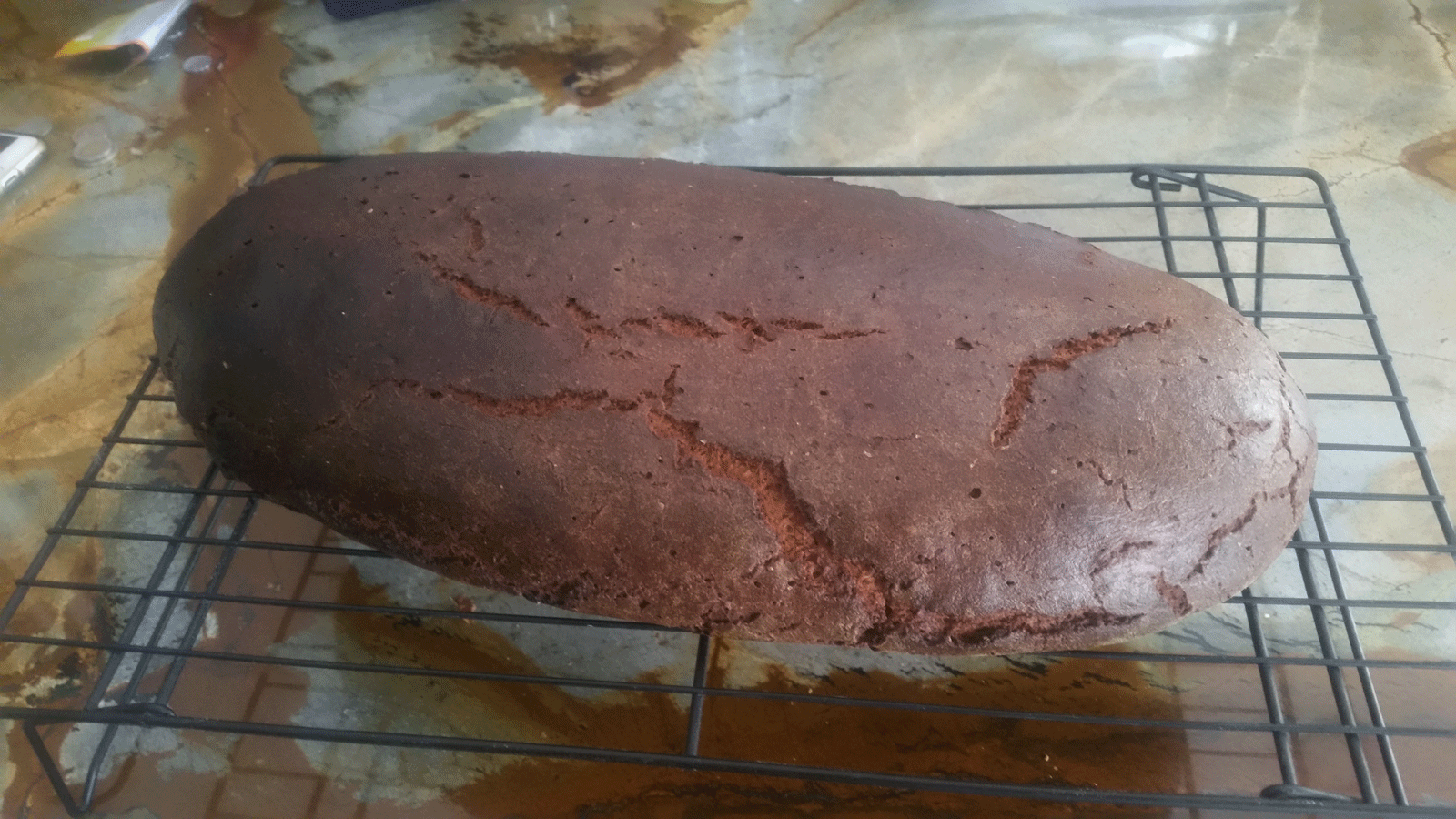
Marisa
April 7, 2017Thank you Stan,
Am busy making 2 other of your bread recipes today, so this one has to wait.
I note caraway in the baker’s percentages but I think it is missing from the ingredients/instructions. (Perhaps kümmel is considered optional for some taste buds (not mine), but is it here an unintentional omission?)
I may have to sub in diastatic barley malt, which was hard enough to source where I live, as I have yet to make time to sprout/malt rye).
This website is interrupting progress in baking my way through your book! 😉 Thanks again.
Stanley Ginsberg
April 7, 2017You’ll find the caraway in the scald ingredients.
Marisa
April 7, 2017Excellent. Thanks. Manifest risk of reading web pages on my old phone.
Steve
April 7, 2017Is this the same as the Riga Rye in your book? They look similar.
Stanley Ginsberg
April 7, 2017Similar in appearance, different in preparation: the Riga Rye uses only one sponge-scald that ripens for 3-5 hours; the Latgalian Rye uses a two-stage method that requires about 18 hours.
Steve
April 7, 2017Thanks!
Władysław
April 9, 2017How it is, that the wholegrain rye bread has such a light coloured crumb?
Stanley Ginsberg
April 9, 2017Wholegrain doesn’t necessarily produce a dark crumb; a lot of it has to do with baking temperature, duration of baking and presence or absence of sugars in the dough. The Maillard reaction (browning) takes place between 280-330F/140-165C, temperature ranges that a loaf’s internal temperature never reaches.
Władyslaw
April 9, 2017Do you use diastatic or normal malt?
Stanley Ginsberg
April 9, 2017The pale malt is diastatic; the red malt is not.
Rick
June 22, 2017Hello Stan,
Under Scald (Day 1, Morning):
You specify, In the mixer bowl, mix the scald ingredients by hand into a firm porridge, cover and let stand at 150°F/65°C until it smells like apples, has a sweet taste and the consistency of pancake batter, 10-12 hours.
Under Sour-Scald 1 (Day 1, Afternoon)
You specify, combine the sponge and scald, cover and let stand at 130°F/55°C until it has a strong smell of apple cider, 6-7 hours.
How do you maintain these specific temperatures for these lengths of time? My electric oven has a minimum temp of 170F. Also can you define Opara?
Thank you, and I’m looking forward to receiving your book!
Stanley Ginsberg
June 24, 2017hi Rick,
To reach those temperatures, preheat your oven until the indicator light goes on (or off) and then turn it off. Put the sponge mixture in the oven and turn on preheat for 5 minutes or so every 3-4 hours. If your oven door has a glass insert, even better, since you can perch an oven thermometer in plain sight and use the preheat setting accordingly. Same thing with the sour-scald.
An opara is a yeasted sour-scald. You’ll find lots more information on compound sponges in my book.
Andy
April 30, 2020Is the 10-12 hours in the first steps a typo. 1-2 maybe. Otherwise the times here don’t make sense.
Stanley Ginsberg
May 6, 2020No, the long initial fermentation/scald are correct. Subsequent steps should start Day 2, morning. Recipe corrected.
Stanley Ginsberg
May 6, 2020recipe revised.
Skaidra
January 7, 2020I just made this extraordinary loaf for the first time. Thanks for including it on the website! My question is, how do you finesse these large Baltic ryes to keep them from bursting in the oven? I think I see in the photo here that the loaf was docked (maybe a dozen times?) before baking. I didn’t do that, and mine opened up lengthwise across the top in the oven. Even when I have docked the Rīga Rye (recipe from the book), it bursts along the edges near the pan. When you find these loaves in the market, the crust is smooth, glossy, and faultless. Is there any trick to getting this result at home?
Eric
June 10, 2020Hey Stan,
Thanks for the recipe. Really looking forward to this one. A question on the 10-12 hours with the instant yeast: would it be feasible to get the yeast active and then let the opara sit in the fridge for a longer time, say an extra 6 hours, as opposed to room temperature for 10-12? Or would that hinder the fermentation *too* much? Trying to plan this bread around my work schedule.
Thanks,
Eric
Stanley Ginsberg
June 23, 2020I’m really leery of retarding rye doughs, simply because the longer times contribute to amylase degradation of the sponge, which can lead to gummy breads. As a rule, I don’t retard.
Norman
June 11, 2020Hi Stanley;
I love these Baltic and Russian breads based on a saccharified scald. Would it be possible to share your source for this bread formula? Thanks.
Stanley Ginsberg
June 23, 2020Frankly, I forget, but it was probably one of the Latvian cooking blogs/sites I check out every few months.
serbacus
August 15, 2020The write up says “The magic starts with a … ***12-hour*** rye flour/pale (diastatic) rye malt/caraway scald.”
The instructions for the scald say “let stand at 150°F/65°C until it smells like apples, has a sweet taste and the consistency of pancake batter, ***16-18 hours.***”
Am I supposed to keep it at 150F for 12 or for 16-18 hours? Thanks
Stanley Ginsberg
January 17, 2021Yes. Use your oven.
Ariana
February 2, 2021Hi Stan,
Very excited to find such thorough instructions when all of the Latvian grandmothers I know “eyeball” everything…
I bought some cracked rye malt from a brewing supply store – should I grind it to a powder for the bread, or leave it in its coarser texture?
Thanks!
Stanley Ginsberg
February 7, 2021hi Ariana. Yes, grind it fine before using.
Kendall
January 21, 2021Hi Stan,
I’ve made this recipe twice…..the flavor is everything you promised….complex and rewarding. I have been having issues with bursting in the baking. I followed the proofing directions, but have had really exaggerated (and not pretty) final results. I know the cracking can be the result of many factors, and in your book you talk about the issues with the very first loaf you baked (not enough proofing leading to too much moisture). Any tips on how to improve the final appearance? Should I be docking the loaf in this recipe?
Stanley Ginsberg
February 7, 2021Docking will definitely help. Also, try proofing a bit longer. The cracking comes from too much oven spring.
Ann
March 23, 2021Hi Stan; I’ve been using your book to try to recreate something similar to Estonian “peenleib” which is a sweet and sour rye bread with a smooth fine texture and strong caraway taste. I am wondering if you know of this bread, and whether it is similar to the Latvian Latgalian rye. I’ve been experimenting with using the rye starter I keep for making heavy dark seeded Estonian rye bread but have not been getting enough of the distinctive sour taste of peenleib. This was a bread that was purchased from Estonian bakers (in Toronto) for special occasions, so finding a “home” recipe has been a struggle. If you have any hints or advice to offer, I would be so grateful. thanks
Stanley Ginsberg
June 15, 2021Estonian rukkileib (which I’ve eaten in Tallinn) is very similar to the Riga Rye in The Rye Baker, but typically baked in a loaf pan.